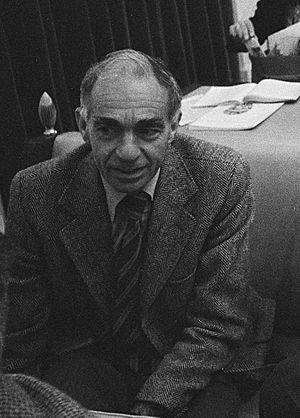Tjalling Waterbolk facts for kids
Quick facts for kids
Tjalling Waterbolk
|
|
|---|---|

Tjalling Waterbolk (1978)
|
|
| Born |
Harm Tjalling Waterbolk
18 May 1924 Havelte, Netherlands
|
| Died | 27 September 2020 (aged 96) Haren, Groningen, Netherlands
|
| Nationality | Dutch |
| Alma mater | University of Groningen |
| Occupation | Archaeologist |
| Scientific career | |
| Institutions | University of Groningen |
| Thesis | De praehistorische mens en zijn milieu : een palynologisch onderzoek naar de menselijke invloed op de plantengroei van de diluviale gronden in Nederland (1954) |
| Influences | Victor Westhoff, Albert Egges van Giffen |
Harm Tjalling "Tjalling" Waterbolk (born May 18, 1924 – died September 27, 2020) was a famous Dutch archaeologist. He taught archaeology at the University of Groningen and led its Biological-Archaeological Institute from 1954 to 1987. Tjalling Waterbolk was special because he mixed archaeology with his love for nature and landscapes. He worked in many countries but especially loved the northern Netherlands, like his home province of Drenthe.
Contents
Becoming an Archaeologist
Tjalling Waterbolk was born on May 18, 1924, in Havelte, a town in the Netherlands. His dad, Albert, worked for the local government. From a young age, Tjalling loved nature. His parents, teachers, and neighbors all helped him explore this interest.
In 1942, he joined a Dutch youth group focused on nature. This made him even more interested in the natural world. He went to the University of Groningen to study biology and then botany. There, he learned about how plants grow together from his mentor, Victor Westhoff.
Discovering Archaeology
In 1945, Tjalling met Albert Egges van Giffen, a well-known archaeologist. Van Giffen was looking for someone who understood palynology, which is the study of pollen and spores. Tjalling had this knowledge. He then worked as an assistant for Van Giffen from 1945 to 1951.
In 1946, Tjalling did his first archaeological dig in his hometown of Havelte. He couldn't take his university exams until 1948 because of rules from World War II. In 1949, he spent six months in Denmark learning from a scientist named Johannes Iversen, who studied ancient environments. Tjalling earned his PhD from the University of Groningen in 1954. His research was about how ancient people affected plant life in the Netherlands.
Archaeological Work and Discoveries
After getting his PhD, Tjalling Waterbolk became a professor of archaeology at the University of Groningen in 1954. He took over from Albert Egges van Giffen. He taught about prehistoric and early Germanic cultures. Besides teaching, he was also the director of the Biological-Archaeological Institute. He retired in 1987 but kept writing, publishing 120 more academic papers.
Exploring the Past
Waterbolk's archaeological work covered a long time, from prehistory to the Middle Ages. He helped develop and use new methods like radiocarbon dating and palynology in the Netherlands. These methods help scientists figure out how old things are and what ancient environments were like.
He led digs in many places, including the Netherlands, Switzerland, Syria, Serbia, and Turkey. He was especially interested in the northern Netherlands and the province of Drenthe. There, he led important excavations in towns like Odoorn, Elp, and Gasselte. He studied how agriculture spread in ancient societies.
Waterbolk also loved studying ancient house plans and how people shaped the cultural landscape. He combined different sciences in his work, like geology (study of Earth's rocks), soil science (study of soil), biology (study of living things), and physical and historical geography (study of Earth's features and how they changed). Many people saw him as one of the most important Dutch archaeologists after World War II.
In 1970, Tjalling Waterbolk was chosen to be a member of the Royal Netherlands Academy of Arts and Sciences. This is a very high honor for scientists in the Netherlands.
The Tjerk Vermaning Case
Tjalling Waterbolk was involved in uncovering a big archaeological mystery in the 1960s and 1970s. A man named Tjerk Vermaning claimed he found very old stone tools. At first, Waterbolk thought these tools were real and thousands of years old.
However, in 1975, Waterbolk's assistant, Dick Stapert, found that the tools were actually fakes. This discovery caused a lot of trouble. The case made it harder for academic archaeologists and amateur archaeologists to work together in the northern Netherlands. It even led to threats against Waterbolk and Stapert. Some people wondered if Waterbolk should have found out about the fakes sooner. Even after he retired, Waterbolk tried to explain what happened. In 2003, he wrote a book about his side of the story.
Later Life
In 2015, a book called Werk van Eeuwen (Work of Ages) was published. It shared conversations with Tjalling Waterbolk. In 2019, when he was 95 years old, he wrote his own life story called Veranderend leven (Changing Life).
Tjalling Waterbolk was married to a botanical analyst, a scientist who studies plants. He met his wife through the same nature youth group he joined when he was young. He once joked that the most beautiful thing he ever "dug up" was his wife! Tjalling Waterbolk was an honorary member of a group called Het Drentse Landschap, which protects nature in Drenthe.
Tjalling Waterbolk passed away on September 27, 2020, in Haren, Groningen, at the age of 96.

